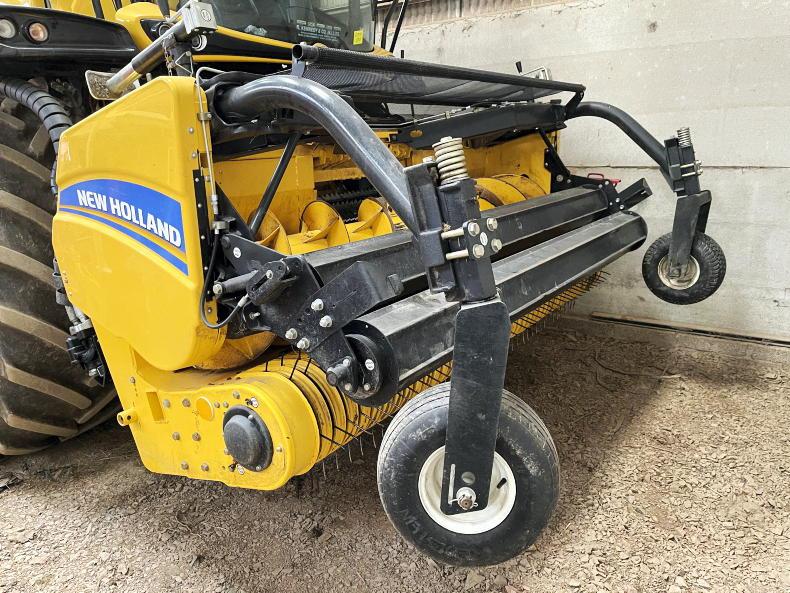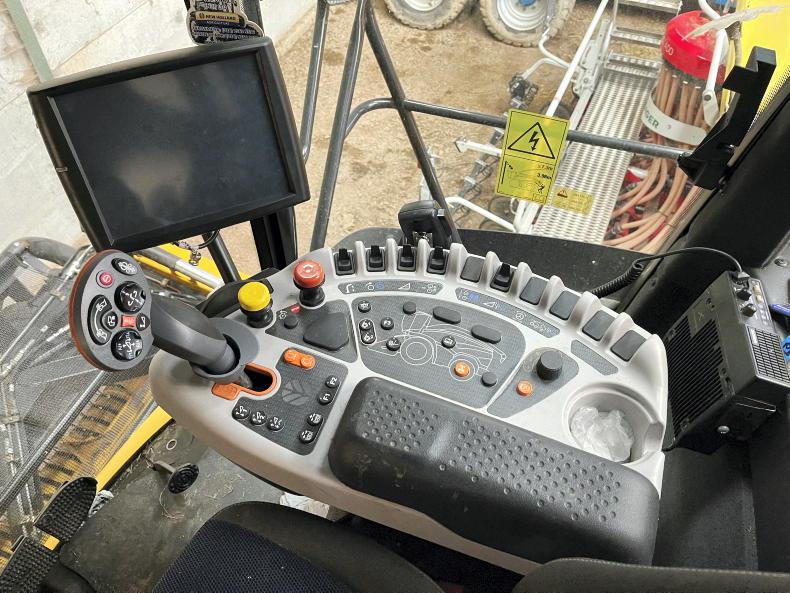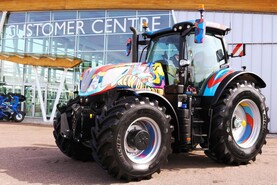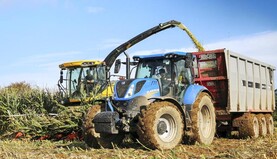Based outside Downpatrick, near the village of Crossgar in Co Down, JDS Contracts is owned and run by Adrian Douglas and his two sons Mark and Stuart, who are the third generation to become involved in the family business.
Adrian recalls being handed the ropes by his father 1985. Today, alongside the contracting, Adrian runs a herd of suckler cows and finishes weanlings.
Since the start, silage has been one of the major services provided by JDS Contracts, with the company now lifting in the region of 4,800 acres.

JDS Contracts replaced a five year old New Holland FR600 with an FR650 ahead of the 2020 season.
Adrian remembers lifting grass with an old Mengele SH30 trailed harvester before making the move to the first self-propelled harvester in the early 1990s, which was a Claas Jaguar 690.
Interestingly, this was the first of three consecutive Claas machines (840, 850) to enter the fleet. He then went to New Holland for a period before returning to Claas in 2012 with another Jaguar 850.
Foragers to date
“When it came to changing the Jaguar 850, at the time we priced around among brands. New Holland had a good reputation in the area for its FX series foragers, with a dealer nearby. We dealt on an FX40, it ticked the most boxes with price being the major attraction,” Adrian said.
The FX40 earned its keep in the fleet for six years.
“It was a good-going harvester, but its two main problems were that its header constantly needed work every season and that it was prone to going on fire, like most FXs were.
“You just had to keep a very close eye on it, blow it down regularly, keeping dry grass from building up in and around the blower and places.”
Things were going well by 2010. The business was growing and it was time to upgrade the forager.
Having been impressed overall by the FX and its relatively low running costs, Adrian stuck yellow, this time opting for the new FR series which replaced the FX.
The FR9050 came about, which he could only describe as being a disappointment.
“Although it should have had more power than the FX, it didn’t seem like it. It gave plenty of blower trouble. We held on to it for two seasons and moved it on.”
It was back to a new Jaguar 850 for the 2012 season. According to Adrian, it wasn’t a lucky machine either and gave its fair share of bother before being traded.
By the next time around, New Holland had updated its FR range, ironing out previous issues. A deal was done for an FR600.
“The FR600 was a major improvement from the FR9050, especially in terms of power and in the blower department.
“Its low maintenance costs over its five years was a major attraction. The difference was day and night compared to the previous machines.
“When upgrading again for the 2020 season, we priced around, as we always do. The Krone 680 seemed like a good machine and a brand we wouldn’t be opposed to running in the future, but, financially, it didn’t add up to go down that route at the time.
“An 880 Jaguar didn’t quite make the budget either. Anyway, we went with the FR650, which replaced the FR600 model, and haven’t looked back since.”
The machine
Now with one season and roughly 4,800acres under its belt, the FR650 is ready for the busy months ahead.
It sits in the line-up as New Holland’s mid-range forager offering, with the FR780 and flagship FR920 above it. It is powered by a 15.9l six-cylinder FPT Cursor 16 engine, capable of churning out 653hp. Maximum torque is 2751Nm at 1,500rpm.
“The difference in torque between the FR600 and FR650 is night and day,” Adrian said.
Fuel consumption is another area that has improved.
“Last season, we burned roughly 5.5l/ac, which is a saving of 1.0l/ac over compared to the FR600, almost 16%.”
The FR650 is equipped with a four-speed hydrostatic gearbox, with a top speed of 40km/h. Four-wheel drive is transferred to the rear axle via a prop shaft compared with the hydrostatic setup on rival machines.

The cooling pack in the FR650 is much better at keeping free from debris.
Adrian noted that the tight steering lock is a bit of a love-hate feature. As good and all as the lock is, turning at the headland in 4wd can cause the wheels to scrub the surface.
To overcome this, Adrian disengages 4wd on approaching the headland every time. The Terralock feature does this automatically and is something Adrian would like to see fitted to the machine.
Header and crop channel
For the most part, the header is unchanged from the FR600. Adrian says it does its job and cannot be faulted.
The header is equipped with New Holland’s Autofloat system, which uses a combination of sensors to automatically adjust its position hydraulically to ensure accurate following of uneven terrain.
Cutting a small amount of whole crop, JCS Contracts opts to pre-mow it and use the standard grass header. Maize cutting is taken care of by another local contractor who also runs an FR650.
The crop intake channel and feed roller system is a particular feature Adrian likes. All models in the range have one 860mm feed opening, unlike rivals which offer narrow and wide-body machines.
After passing through the four feed rollers, crops enter the 884mm-wide drum, which is fitted with 20 knives (2x10) arranged in a V-shape, chopping to a length of 24mm.
The sharpening system is one of the major improvements.
“Everything is automatically set now. Before sharpening, we used to always blow down around the header and drum regularly, but not so much now, given less material tends to build up.
“The tweaked airflow design means that material blows away from the drum and places like around the cooling pack better.”
The FR650 has a good blow regardless of the crop or conditions.
“The FRs all have longer spouts too, which you’d notice straight away moving from Claas. The drivers would naturally be a lot closer to you until used to it.
“Having them that bit further away leaves visibility better too. For the first time, we opted for the HD liner package, which we had fitted from new. It will be interesting to see how it lasts.”

The pickup remains unchanged from the FR600 for the most part, Adrian noted.
Cab and features
The cab of the FR650 benefits from the updated New Holland livery, most notably the seat and joystick.
“The IntelliView monitor is very easy to use, with all switchgears near at hand too. A niggly thing is that the harvester defaults to eco mode upon start-up, which took some getting used to.
“Visibility and space in the cabin cannot be faulted,” he said.
Another small but improved feature are the two rear toolboxes, which prove to be handy storage locations, Adrian commented.

Inside the cab is the latest joystick and updated command arm encompassing all machine controls.
Interestingly, this is the first forager Adrian has had fitted with an auto greaser, a must-have feature in future he noted, having witnessed time saved in the mornings.
Making use of the optional 390l on-board additive tank, Adrian opted for the yield and moisture measuring systems too, which prove handy tools, especially when applying additives.

Adrian Douglas of JDS Contracts based outside Downpatrick Co Down.
Verdict
“The FR650 has been by far the best forager we’ve ran from an all-round point of view. From increased power and torque to improved fuel economy, it can’t be faulted.
“The increased fuel saving is somewhere up to 16% on the FR600. It seems to tackle whatever is thrown at it and holds on much better as engine rpm decreases, proving its torque.
“The auto greaser has been another worthy option. Another big improvement is its ability to remain much cleaner, especially in around the blower and cooling pack.
“It has a few small issues and areas that could be improved upon. The main issue being the headland scrubbing in 4wd and a yield mapping issue that has been sorted after some time.
“Low running costs and reliability are two important characteristics you like to see with any machine, something New Holland seem to have got fairly right this time around. So far, it’s been a case of sharpen it, dip it for oil and drive it – let’s hope it continues that way.”
? Likes
Low running costs.Fuel consumption.Reliability.? Dislikes
Having to disengage 4wd manually at headlands.Defaults to eco mode on start-up.Specs
Engine: 15.9l Six-cylinder FPT Cursor 16.Horsepower: 650hp @ 1,700-1,900rpm.Transmission: 40km/h hydrostatic.Chopping cylinder: 20 knives (2x10).Pickup: Five tine bar with cam track.Fuel tank capacity: 1,200l.Tyres: 710/70 R42 front, 540/65 R30 rear.Weight: 15,540kg.List price: €362,000 plus VAT.
Based outside Downpatrick, near the village of Crossgar in Co Down, JDS Contracts is owned and run by Adrian Douglas and his two sons Mark and Stuart, who are the third generation to become involved in the family business.
Adrian recalls being handed the ropes by his father 1985. Today, alongside the contracting, Adrian runs a herd of suckler cows and finishes weanlings.
Since the start, silage has been one of the major services provided by JDS Contracts, with the company now lifting in the region of 4,800 acres.

JDS Contracts replaced a five year old New Holland FR600 with an FR650 ahead of the 2020 season.
Adrian remembers lifting grass with an old Mengele SH30 trailed harvester before making the move to the first self-propelled harvester in the early 1990s, which was a Claas Jaguar 690.
Interestingly, this was the first of three consecutive Claas machines (840, 850) to enter the fleet. He then went to New Holland for a period before returning to Claas in 2012 with another Jaguar 850.
Foragers to date
“When it came to changing the Jaguar 850, at the time we priced around among brands. New Holland had a good reputation in the area for its FX series foragers, with a dealer nearby. We dealt on an FX40, it ticked the most boxes with price being the major attraction,” Adrian said.
The FX40 earned its keep in the fleet for six years.
“It was a good-going harvester, but its two main problems were that its header constantly needed work every season and that it was prone to going on fire, like most FXs were.
“You just had to keep a very close eye on it, blow it down regularly, keeping dry grass from building up in and around the blower and places.”
Things were going well by 2010. The business was growing and it was time to upgrade the forager.
Having been impressed overall by the FX and its relatively low running costs, Adrian stuck yellow, this time opting for the new FR series which replaced the FX.
The FR9050 came about, which he could only describe as being a disappointment.
“Although it should have had more power than the FX, it didn’t seem like it. It gave plenty of blower trouble. We held on to it for two seasons and moved it on.”
It was back to a new Jaguar 850 for the 2012 season. According to Adrian, it wasn’t a lucky machine either and gave its fair share of bother before being traded.
By the next time around, New Holland had updated its FR range, ironing out previous issues. A deal was done for an FR600.
“The FR600 was a major improvement from the FR9050, especially in terms of power and in the blower department.
“Its low maintenance costs over its five years was a major attraction. The difference was day and night compared to the previous machines.
“When upgrading again for the 2020 season, we priced around, as we always do. The Krone 680 seemed like a good machine and a brand we wouldn’t be opposed to running in the future, but, financially, it didn’t add up to go down that route at the time.
“An 880 Jaguar didn’t quite make the budget either. Anyway, we went with the FR650, which replaced the FR600 model, and haven’t looked back since.”
The machine
Now with one season and roughly 4,800acres under its belt, the FR650 is ready for the busy months ahead.
It sits in the line-up as New Holland’s mid-range forager offering, with the FR780 and flagship FR920 above it. It is powered by a 15.9l six-cylinder FPT Cursor 16 engine, capable of churning out 653hp. Maximum torque is 2751Nm at 1,500rpm.
“The difference in torque between the FR600 and FR650 is night and day,” Adrian said.
Fuel consumption is another area that has improved.
“Last season, we burned roughly 5.5l/ac, which is a saving of 1.0l/ac over compared to the FR600, almost 16%.”
The FR650 is equipped with a four-speed hydrostatic gearbox, with a top speed of 40km/h. Four-wheel drive is transferred to the rear axle via a prop shaft compared with the hydrostatic setup on rival machines.

The cooling pack in the FR650 is much better at keeping free from debris.
Adrian noted that the tight steering lock is a bit of a love-hate feature. As good and all as the lock is, turning at the headland in 4wd can cause the wheels to scrub the surface.
To overcome this, Adrian disengages 4wd on approaching the headland every time. The Terralock feature does this automatically and is something Adrian would like to see fitted to the machine.
Header and crop channel
For the most part, the header is unchanged from the FR600. Adrian says it does its job and cannot be faulted.
The header is equipped with New Holland’s Autofloat system, which uses a combination of sensors to automatically adjust its position hydraulically to ensure accurate following of uneven terrain.
Cutting a small amount of whole crop, JCS Contracts opts to pre-mow it and use the standard grass header. Maize cutting is taken care of by another local contractor who also runs an FR650.
The crop intake channel and feed roller system is a particular feature Adrian likes. All models in the range have one 860mm feed opening, unlike rivals which offer narrow and wide-body machines.
After passing through the four feed rollers, crops enter the 884mm-wide drum, which is fitted with 20 knives (2x10) arranged in a V-shape, chopping to a length of 24mm.
The sharpening system is one of the major improvements.
“Everything is automatically set now. Before sharpening, we used to always blow down around the header and drum regularly, but not so much now, given less material tends to build up.
“The tweaked airflow design means that material blows away from the drum and places like around the cooling pack better.”
The FR650 has a good blow regardless of the crop or conditions.
“The FRs all have longer spouts too, which you’d notice straight away moving from Claas. The drivers would naturally be a lot closer to you until used to it.
“Having them that bit further away leaves visibility better too. For the first time, we opted for the HD liner package, which we had fitted from new. It will be interesting to see how it lasts.”

The pickup remains unchanged from the FR600 for the most part, Adrian noted.
Cab and features
The cab of the FR650 benefits from the updated New Holland livery, most notably the seat and joystick.
“The IntelliView monitor is very easy to use, with all switchgears near at hand too. A niggly thing is that the harvester defaults to eco mode upon start-up, which took some getting used to.
“Visibility and space in the cabin cannot be faulted,” he said.
Another small but improved feature are the two rear toolboxes, which prove to be handy storage locations, Adrian commented.

Inside the cab is the latest joystick and updated command arm encompassing all machine controls.
Interestingly, this is the first forager Adrian has had fitted with an auto greaser, a must-have feature in future he noted, having witnessed time saved in the mornings.
Making use of the optional 390l on-board additive tank, Adrian opted for the yield and moisture measuring systems too, which prove handy tools, especially when applying additives.

Adrian Douglas of JDS Contracts based outside Downpatrick Co Down.
Verdict
“The FR650 has been by far the best forager we’ve ran from an all-round point of view. From increased power and torque to improved fuel economy, it can’t be faulted.
“The increased fuel saving is somewhere up to 16% on the FR600. It seems to tackle whatever is thrown at it and holds on much better as engine rpm decreases, proving its torque.
“The auto greaser has been another worthy option. Another big improvement is its ability to remain much cleaner, especially in around the blower and cooling pack.
“It has a few small issues and areas that could be improved upon. The main issue being the headland scrubbing in 4wd and a yield mapping issue that has been sorted after some time.
“Low running costs and reliability are two important characteristics you like to see with any machine, something New Holland seem to have got fairly right this time around. So far, it’s been a case of sharpen it, dip it for oil and drive it – let’s hope it continues that way.”
? Likes
Low running costs.Fuel consumption.Reliability.? Dislikes
Having to disengage 4wd manually at headlands.Defaults to eco mode on start-up.Specs
Engine: 15.9l Six-cylinder FPT Cursor 16.Horsepower: 650hp @ 1,700-1,900rpm.Transmission: 40km/h hydrostatic.Chopping cylinder: 20 knives (2x10).Pickup: Five tine bar with cam track.Fuel tank capacity: 1,200l.Tyres: 710/70 R42 front, 540/65 R30 rear.Weight: 15,540kg.List price: €362,000 plus VAT. 










 This is a subscriber-only article
This is a subscriber-only article










SHARING OPTIONS: